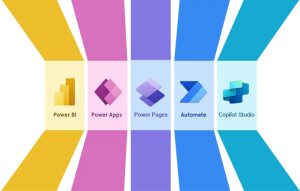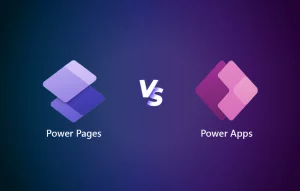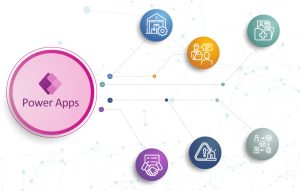There’s an app for that! We have perhaps turned to say this several times. There are more than two million applications available across platforms, which are used by consumers from all over the world. However, for businesses, there isn’t just one that does whatever we are searching for. Hence, companies find it challenging to address their issues like analyzing data, developing solutions and automating processes. That is why a variety of businesses turn to Power Apps to find the answer to their needs.
Microsoft’s Power Apps are built to do more than just solve your problems. Power Apps not only helps you to equip performance improvements and productivity but also helps to transform innovations into operational solutions by providing you with the ability to create custom applications. In this blog post, we will explore some of the ideas that you can use to turn into Power Apps business solutions.
How you can start converting ideas into reality with Power Apps
Let’s look at the formulating aspects of converting ideas into Power Apps business solutions including planning your project, creating an app, evaluating its value and more. It may seem a little overwhelming to start designing an app from scratch; that’s why it’s important to have a clear idea of all the details. Here are some of the basic steps to assist you in transforming your ideas into a fully functioning solution using Power Apps.
1. Planning
The initial planning stage focuses on putting together bits of information and collecting business process requirements that you would like to automate. Besides, business considerations are also addressed, for example, how to optimize business processes and perform business value assessments.
2. Designing
The designing stage covers the conceptual and architectural design of your app including the technical aspects, modeling the different data types and dealing with several systems and more. In short, you must determine how data will be handled, structured, accessed and displayed on your app screens.
3. Creating
This stage guides you to reliable documentation for creating canvas apps and model-driven apps. Alongside this, you can discover the tips for better collaborative development of solutions when multiple app makers are working simultaneously.
4. Testing
Testing involves different types of tests to be performed, such as user acceptance tests and unit tests, as well as developing and executing test case scenarios. The best thing is to have your internal teams try the app and provide you genuine feedback.
5. Deploy
Finally, this segment verifies that the applications you developed are used, ensuring that users have the right visibility to the apps and receive feedback to enhance the apps in the future.
Here are some conceptual ideas to help you get started with Power Apps
1. Making data entry easy
If you’ve dealt with any customer relationship management (CRM), you would agree that data-entry is a time-consuming process for any business. Although, filling new entries of customers may seem like a quick activity, it can get tedious when profiles multiply to thousands. Besides, keeping your employees motivated for mundane tasks can be challenging. Fortunately, we have Power Apps to overcome similar repetitive tasks. Using Power Apps, you can design a business app for your team to easily navigate data. This is also an efficient way to reduce any manual errors.
2. Improving employee on-boarding process
A notable aspect of Microsoft Power Apps is its ability to integrate seamlessly with data that is stored in other Office applications such as Outlook, tasks, calendars and other Microsoft 365 services. You can welcome a new employee by building an onboarding app that collaborates resources like policy manuals, team member contacts and forms into a single place to ensure that employees have a hassle-free onboard experience. This will also simplify and enhance HR personnel’s role in embarking on new hires. Microsoft provides a Power Apps Office Template named ‘Onboarding Tasks’. It serves as a tool to add new team members, fill out their Office 365 user profiles as well as track their other onboarding activities such as assigned system login and more.
3. Monitoring expense approval system
Managing the expenses and keeping a track of their approval can be a tedious task for many organizations as it includes submission and verification of documents and receipts. A competent approval system can help you with speedy reimbursements, especially to facilitate your remote teams.
Using Power Apps, you can create an extended app with a mobile-friendly interface and set up a customized approval system. Your employees and vendors can file their claim expense request with valid proofs and the manager in-charge will receive an instant notification on new request so that the team can get the information reviewed faster. As soon as the claims get processed, the requester will be notified to take the next action.
Further, the app can also be integrated with your existing human resource or accounts system to transfer requests and update status, helping your employees save time.
4. Finding out what’s trending on social media
Tracking trending hashtags over social media channels can be tedious and challenging. So, how about building an app to help you save the hashtags automatically from your best-performing posts? It’s a perfect way to support your social media team and gain insights of how your content is performing with your audience. Besides, you can effectively deliver what your audience is interested in, without having to scroll through your feed.
The closing thought
Every business has unique requirements for finding the right business app, but often it’s not readily available on the market. With Microsoft Power Apps, you can also integrate your external data systems like CRM, ERP etc. to build great business apps. These can help to enhance automation and boost your company’s operational efficiency and productivity. So, start building your own apps; your own way using Power Apps.
Regardless of your industry or coding skills, you can still turn your ideas into business apps and optimize your processes more than ever. If you need guidance with more complex solutions have a look at our range of Power Apps consulting services.









